DTC Trends Every Ecommerce Brand Must Know in 2025
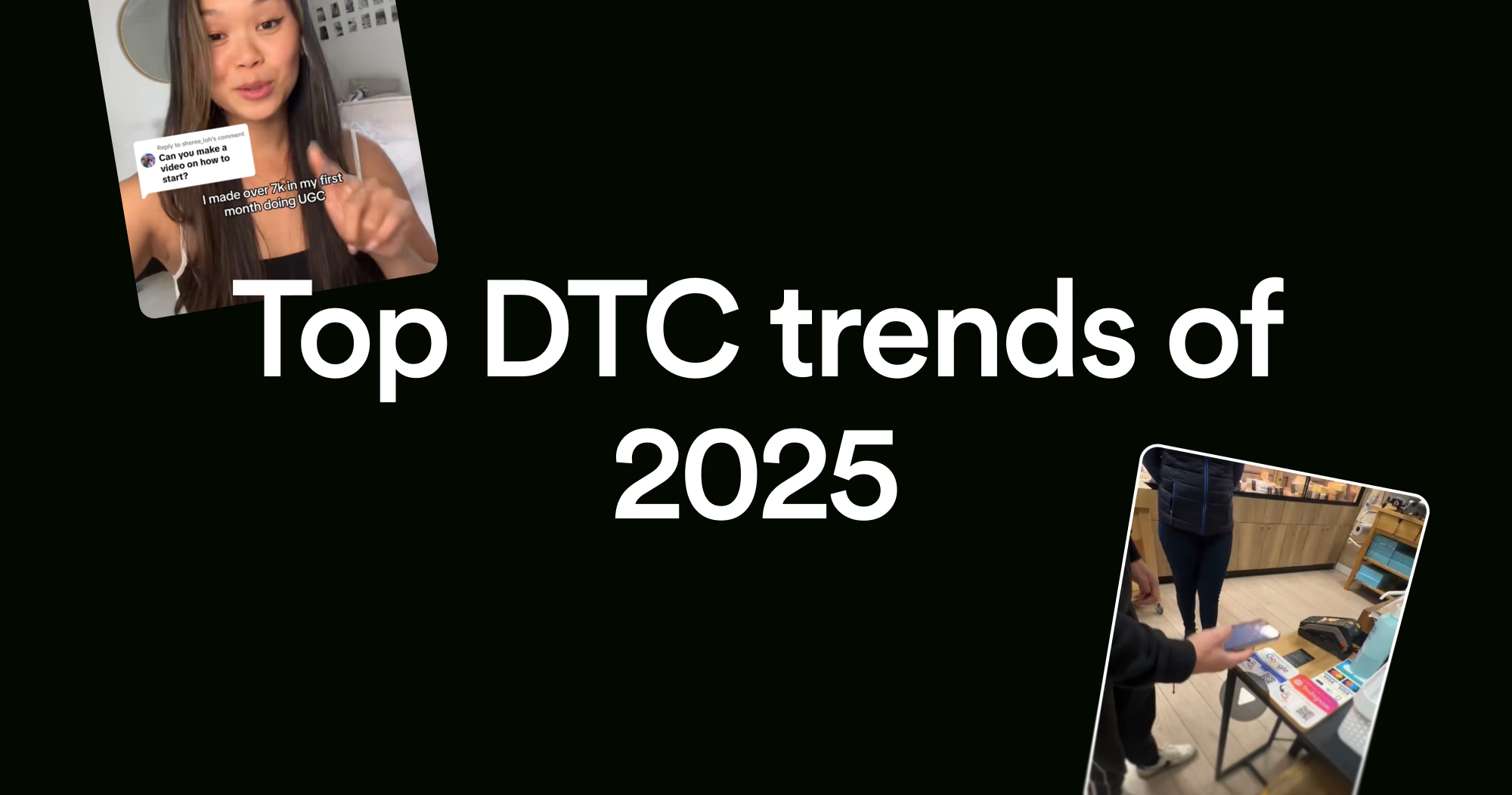
It is a fact that many ecommerce enthusiasts are fixated on discovering the next big product. However, the true success in 2025 belongs to brands that identify emerging consumer behaviors long before they become mainstream.
The direct-to-consumer (DTC) market has just undergone its most significant upheaval since the pandemic.
TikTok Shop, for example, generated over $11 billion in sales across Southeast Asia alone. Meanwhile, zero-party data collection boosted conversion rates by as much as 90% for early adopters.
At the same time, AI-driven personalization is fueling an impressive 15–20% increase in average order values.
These aren't gradual changes—they're seismic shifts that separate tomorrow's market leaders from today's also-rans. The DTC eCommerce trends dominating 2025 reward founders who read consumer psychology, not just sales reports.
DTC eCommerce Trends Dominating 2025
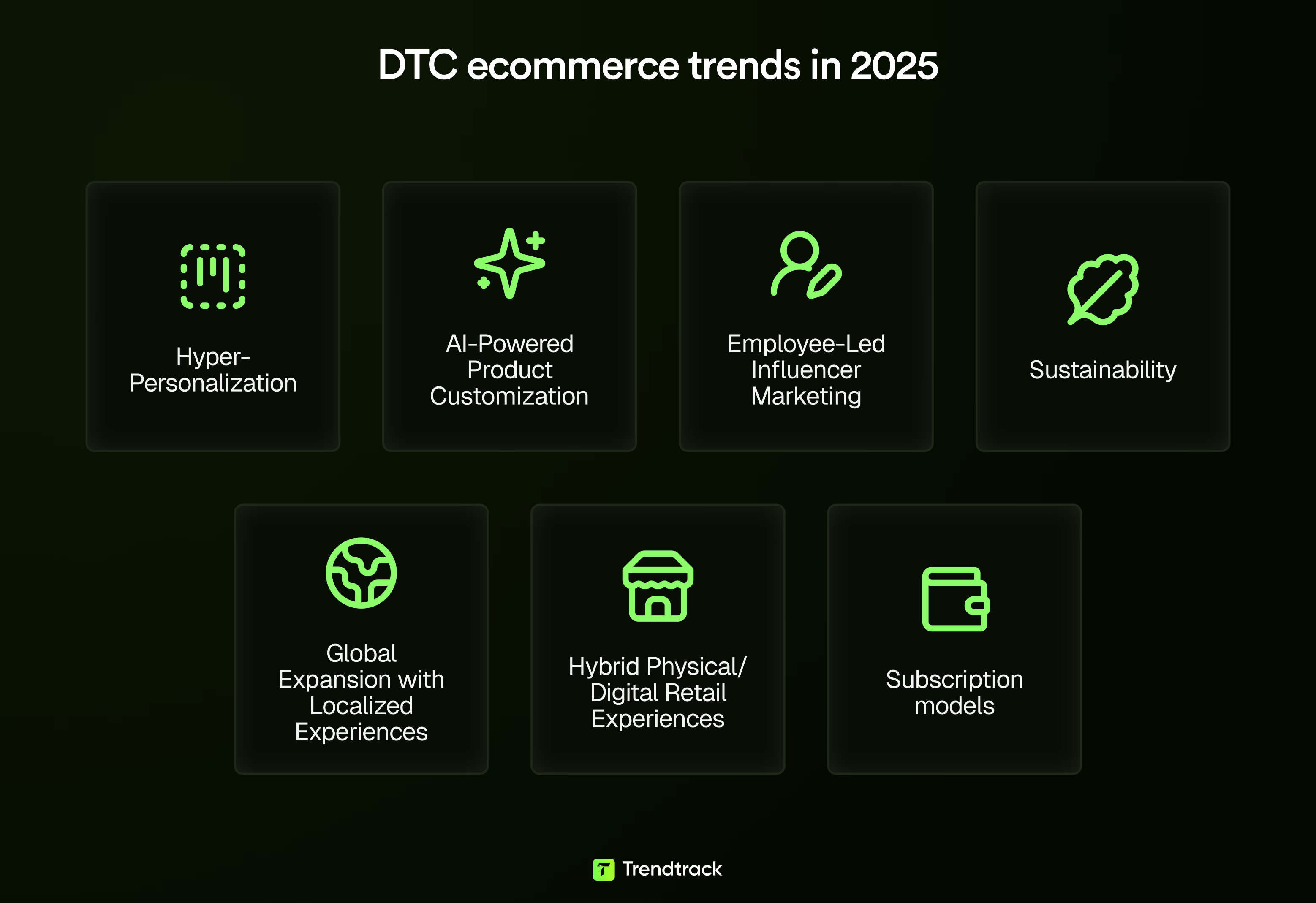
The DTC market has grown from small startups to a $200 billion global industry. In 2025, seven key trends will define success for DTC brands. While traditional retailers struggle, smart DTC founders are already leveraging these trends to outperform competitors.
1. Hyper-Personalization Through Zero-Party Data Collection
Privacy rules have changed how brands collect data. Yet, shoppers still want personalized experiences. Zero-party data solves this by using interactive quizzes, polls, and surveys that customers willingly complete. Because they receive value in return.
Jones Road Beauty uses TikTok ads to direct shoppers to a beauty quiz. Instead of generic product pages, customers answer questions about their skin and get tailored recommendations.
This approach increased their average order value from $60 to $90. Boosted conversion rates to 16%, and collected over 50,000 emails in one month.
The key is the experience. When customers help shape their journey, they become more engaged. This method builds trust and makes product discovery a collaborative process.
2. AI-Powered Product Customization at Scale
Generative AI is transforming shopping. By 2025, AI tools will do more than answer questions. They will display product carousels, reviews, and direct purchase links tailored to each shopper.
Research shows that many of online shoppers say AI improves their experience, and they are likely to use AI for product research. Among Gen Z, this rises to 50%. Brands that optimize for AI-powered searches and recommendations will gain a competitive edge.
Omy Laboratories leads with AI-driven personalized skincare created through virtual consultations. Their AI customization accounts for 95% of their online sales. AI-powered mass customization is now both exclusive and profitable.
3. Employee-Led Influencer Marketing Programs
Influencer marketing costs are rising. In 2024, 14.5% of businesses spent over $500,000 on influencers. Nearly half spent less than $10,000 or stopped using influencers altogether.
DTC founders are becoming their own influencers. For example, Aimee Smale shared Odd Muse’s story on TikTok and built a following of over 200,000. Her behind-the-scenes content created authentic connections that generic posts cannot match. She credits this approach for her brand’s growth. With formats like TikTok Spark Ads, founders and brands can now take this type of organic, authentic content and amplify it as paid media: extending reach while preserving the credibility of the original post.
Brands also encourage employees to share genuine stories about company culture, product development, and customer successes. This creates a network of authentic influencers that costs little and builds trust with skeptical shoppers.
4. Sustainability As Core Brand Differentiator
Sustainability is essential, especially for Gen Z, who lead DTC purchases. In 2025, it goes beyond eco-friendly packaging to include transparent supply chains, ethical labor, and circular business models.
Brands use blockchain to show customers exactly where products come from. This transparency builds trust and sets them apart from competitors who only make claims.

Shoppers are willing to pay more for sustainable products. Brands with authentic sustainability practices see higher customer lifetime value and lower churn. The key is to integrate sustainability into the product, not just marketing.
5. Global Expansion with Localized Experiences
DTC is growing worldwide, but each region differs. China leads with 20% of online sales as DTC, North America follows at 16%, and India is at 2%. This presents a major opportunity for brands that adapt.
Success requires more than translating websites. Brands must understand local payment methods, culture, and regulations. Partnering with local logistics and payment providers helps create experiences that feel native.
Brands expanding internationally often see 30-50% revenue growth in their first year. Some markets offer better margins due to less competition and unique pricing.
6. Hybrid Physical/Digital Retail Experiences

DTC started online, but top brands now combine digital and physical experiences. This doesn’t mean opening traditional stores but creating spaces that enhance the digital connection.
Pop-ups, showrooms, and brand events attract customers and feed back into online engagement. Shoppers who visit in person have 23% higher lifetime value and 15% lower return rates than online-only customers.
Successful brands link offline and online through QR codes, exclusive digital content unlocked in-store, and physical products with digital extras that maintain customer relationships.
7. Subscription models with premium tiers
Subscriptions grow 18% annually, but winners in 2025 offer tiered experiences that reward loyalty and increase revenue per user.

Butternut Box, a dog food subscription, nearly doubled sales during international expansion. They saw huge search increase over five years. They treat subscriptions as a service. Offering premium tiers with perks like vet consultations, personalized plans, and exclusive products.
These seven trends are reshaping how customers discover, evaluate, and buy products. DTC brands that adopt subscriptions will outperform competitors, launch confidently with real data, and capture market share efficiently.
Reverse-Engineer Successful Stores
Learn exactly what makes top Shopify stores successful. Analyze their traffic sources, apps, themes, and best-selling products to replicate their success.
Data-Backed Strategies to Capitalize on DTC Trends
Timing matters. The difference between riding a trend to success or falling behind is entering at the right moment.
Most DTC founders either jump in too late—when the market is crowded—or too early, before customers care. The real advantage comes from entering when interest is growing but competition is still low.
How to Validate Trend Opportunities Using Trendtrack Data
Trend validation is like reading stock charts. But, instead of prices, you track real consumer behavior across thousands of Shopify stores. The best signals come from converging data points that show real, lasting demand, not just viral spikes.
Use Trendtrack to filter for stores with steady traffic growth over 30 days, not sudden jumps.
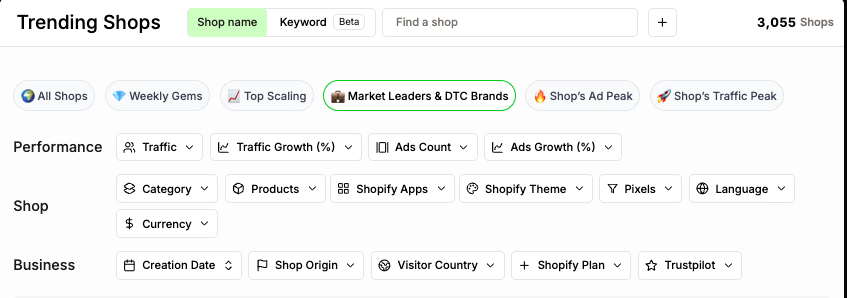
For example:
- A supplement brand growing from 50,000 to 150,000 monthly visits over three months signals real demand.

- A brand jumping from 10,000 to 200,000 visits in a week might be a viral blip.
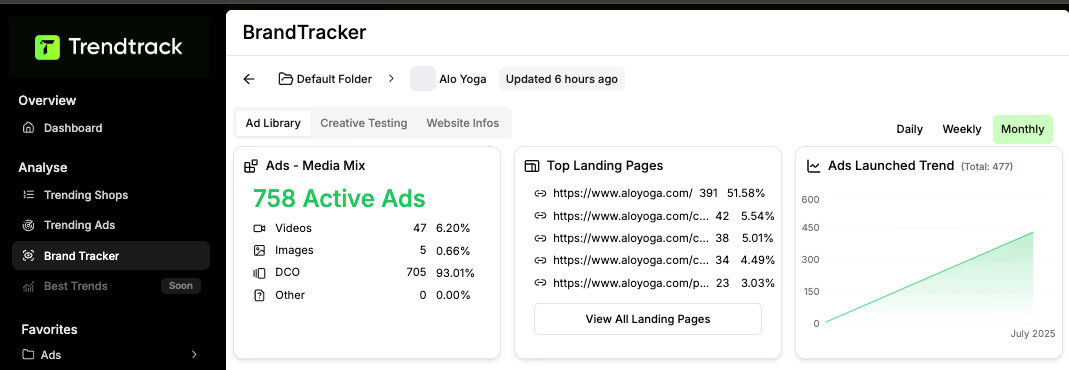
Brandtracker offers valuable insights. When established DTC brands test ads in new categories, pay attention. For example, if several skincare brands start advertising sleep supplements, that signals a strong market opportunity.
Want to see how top DTC brands are leveraging real-time market data? Explore the top 20 brands of 2025!
Building Agile Product Development Cycles
Slow product launches don’t work in trend-driven markets. You need to move fast and stay flexible. The key is using validation loops—quick cycles that test demand before fully committing.

Spacegoods, an adaptogenic mushroom brand, saw a great search growth by starting small. They launched with a minimal viable product, produced in small batches, simply packaged, and easy to ship.
Your product development should match your data collection pace. If you check trends weekly on Trendtrack, test product tweaks, messaging, and positioning just as often. The goal is constant learning and adapting, not launching new products every week.
Athletic Brewing found success by focusing on non-alcoholic beer, a market gap with 408% search growth. Their strategy shows the value of finding gaps in trending categories and building your brand around them.
Optimizing Customer Acquisition Costs
Winning in DTC means getting more value from every acquisition dollar, not just spending less. Treat your acquisition strategy like a smart investment portfolio: diversify, use data, and adjust regularly.
Top brands track blended CAC. The true cost to acquire customers across all channels, including organic social, email, affiliates, and paid ads. Moonboon’s affiliate program generated $1 million in sales with a 6.5x ROI, proving that spreading efforts pays off.
Zero-party data collection transforms customer segmentation by focusing on what customers want, not just who they are. Jones Road Beauty’s quiz boosted conversion rates to 16%, building a database that improves every future campaign.
The best approach builds acquisition funnels that learn and improve. Use Trendtrack to find brands with steady growth and consistent ad spend. This indicates profitable channels. Then, study their ad creative and test similar ideas in your market.
Creating High-Converting Landing Pages
Landing pages have evolved beyond simple tweaks. The best pages act like interactive experiences, adapting to each visitor in real time. Shoppers want personalization, not just products.
Smart DTC brands use creative social proof. Instead of generic testimonials, they show real-time data about what similar customers are buying. Integrating customer data with your website boosts conversions significantly.
It’s not about fancy tech but smart strategy. Your landing pages should reflect the trends driving your category. For example:
- If sustainability is important, highlight your environmental impact.
- If personalization matters, make every visitor feel the page was built just for them.
Use these strategies to validate ideas with real data, launch confidently, and stay ahead of competitors.
How to spot emerging DTC eCommerce trends before competitors
Spotting trends shouldn’t feel like fishing blindfolded. Most store owners waste hours scrolling product feeds. They watch endless “winning product” videos, and check competitor stores one by one. This burns through time and money for sure.
If you're struggling to analyze Shopify stores and winning products, Trendtrack provides you high-growth opportunities in the crowded DTC space. You can spot the data-driven insights you need.
Real-time Tracking of Trending Shops and Products
The Trending Shops tab acts as your live radar for the DTC world. Open your dashboard and instantly see which Shopify stores are experiencing traffic spikes, revenue jumps, and ad momentum. The data updates constantly, so you catch micro-trends before they go mainstream.
For example, if a small skincare brand launches a new serum for Gen Z acne, old-school trend tools might not notice for months. But Trendtrack’s algorithms spot early signs like traffic surges, rising ad spend, and engagement that hint at viral potential.
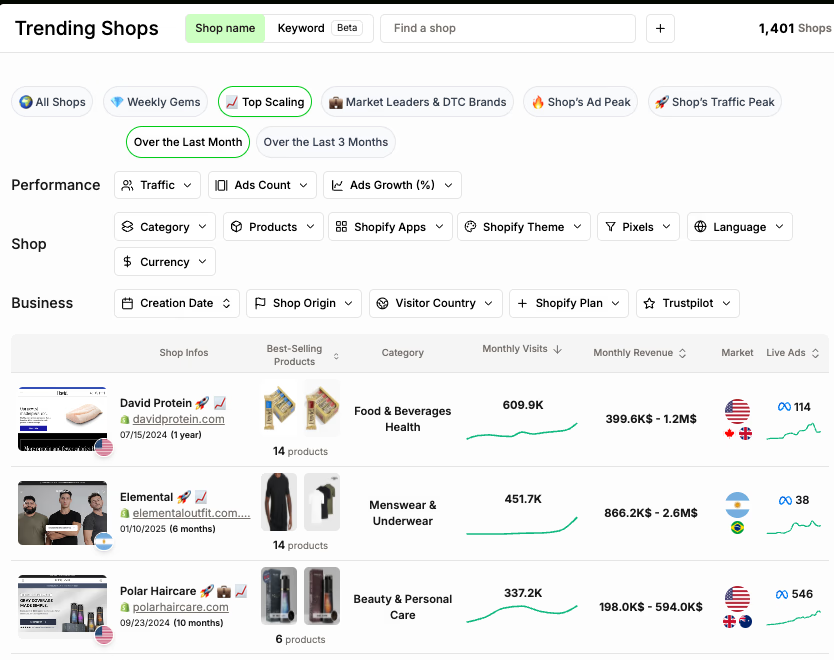
You can filter with laser precision. For instance, find wellness DTC brands making $50,000 to $200,000 a month and scaling fast. Set your filters and let Trendtrack surface those exact opportunities.
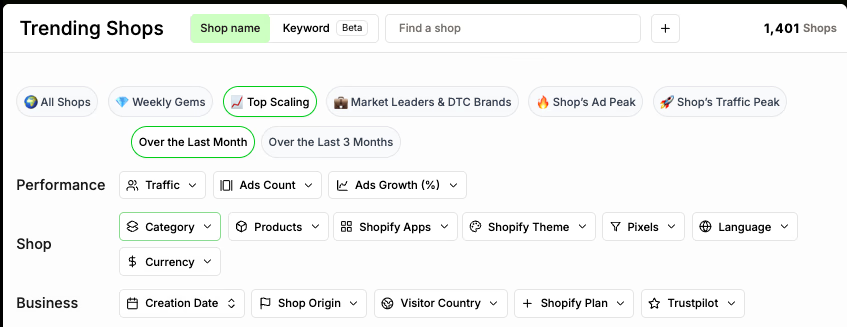
Drill down by:
- Traffic growth
- Ad count
- Shopify app installs that indicate scaling
Advanced Filtering to Identify High-Growth DTC Brands
The real power comes when you combine filters. Start with “Weekly Gems” to spot stores with unusual growth. Then add performance filters such as:
- At least 10,000 monthly visits
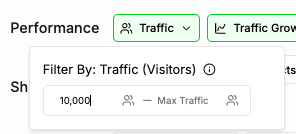
- 50% traffic growth in 30 days
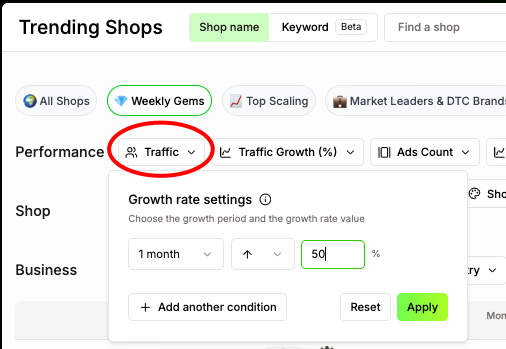
- 20+ active ads
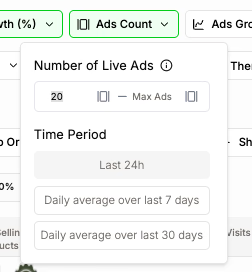
Add a filter for stores launched in the last 18 months to focus on fresh, fast-growing brands.
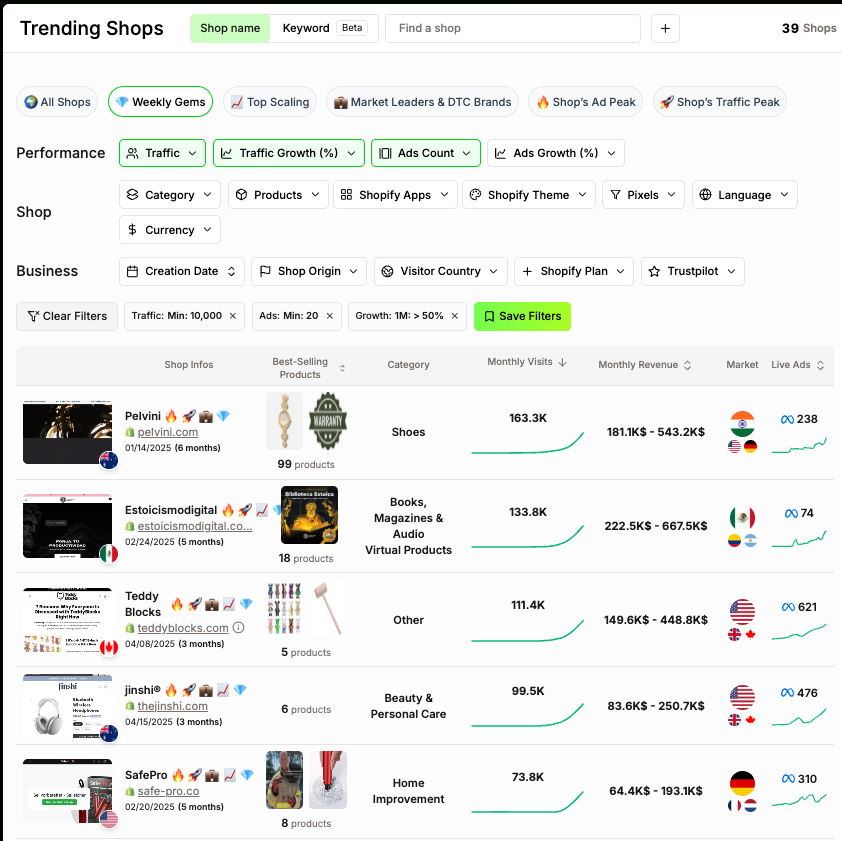
This method reveals patterns you’d miss manually. For example, top DTC pet brands might all use the same subscription app. Or scaling home goods stores could share traffic sources and ad tactics.
Trendtrack monitors 397,803 Shopify stores and analyzes billions of data points daily. You don’t just see what’s hot—you understand what drives the heat. When a product category grows across multiple stores, you watch a new trend take shape.
Your All-in-One E-commerce Intelligence Tool
Stop juggling multiple tools. Trendtrack provides comprehensive store analysis, trend tracking, and ad intelligence in a single dashboard.
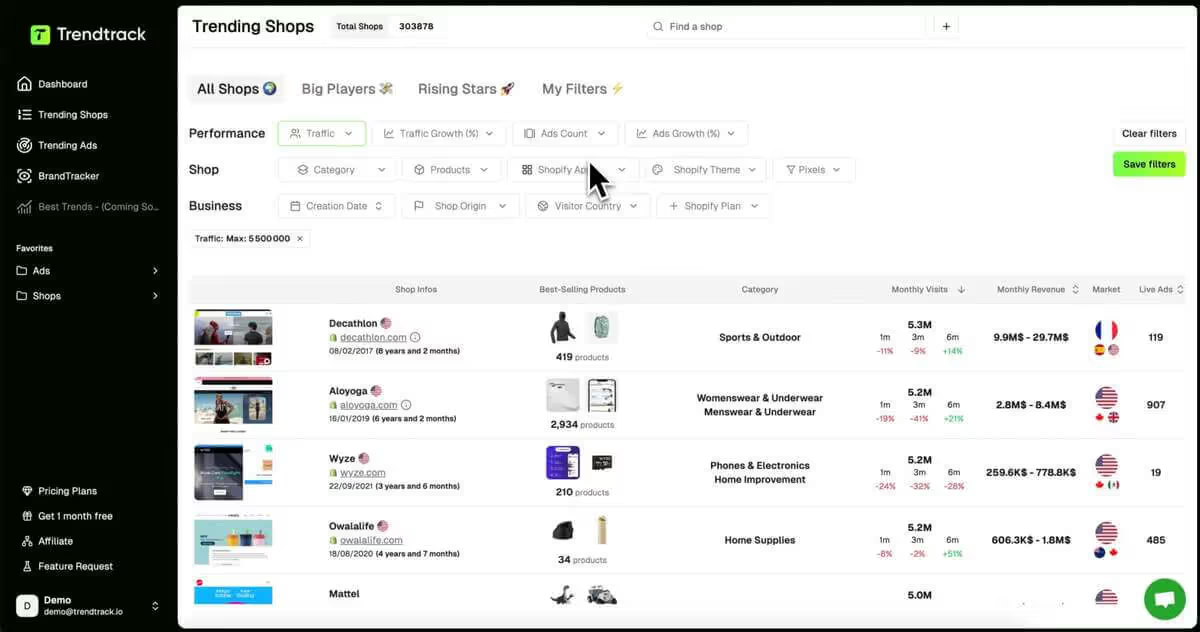
Analyzing Winning Ad Strategies of Successful DTC Stores
The Trending Ads section gives you a backstage pass to every DTC brand’s creative lab. See which ad formats win, how long top campaigns run, and what creative hooks work for different audiences.
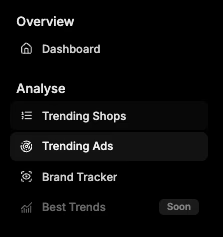
The duplicate tracking feature shows when multiple brands use the same messaging or visuals. This helps you to spot proven formulas to adapt.
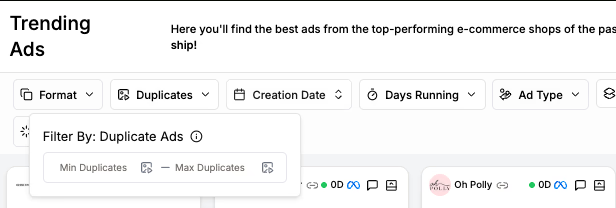
For example, successful skincare video ads often follow this pattern:
Present the problem in the first 3 seconds
- Offer the solution by second 8
- Show social proof before 15 seconds
You’ll notice these trends clearly when reviewing hundreds of successful campaigns at once.
Use creation date and days running filters to track ad lifecycles. Some viral ads last months, others fade quickly. This helps you plan when to refresh your creative and allocate your budget effectively.
Monitoring Competitor Testing Patterns Through Brandtracker
Brandtracker removes guesswork from competitor research. No more manually checking websites—get automatic updates on their ads, product launches, and strategy shifts.
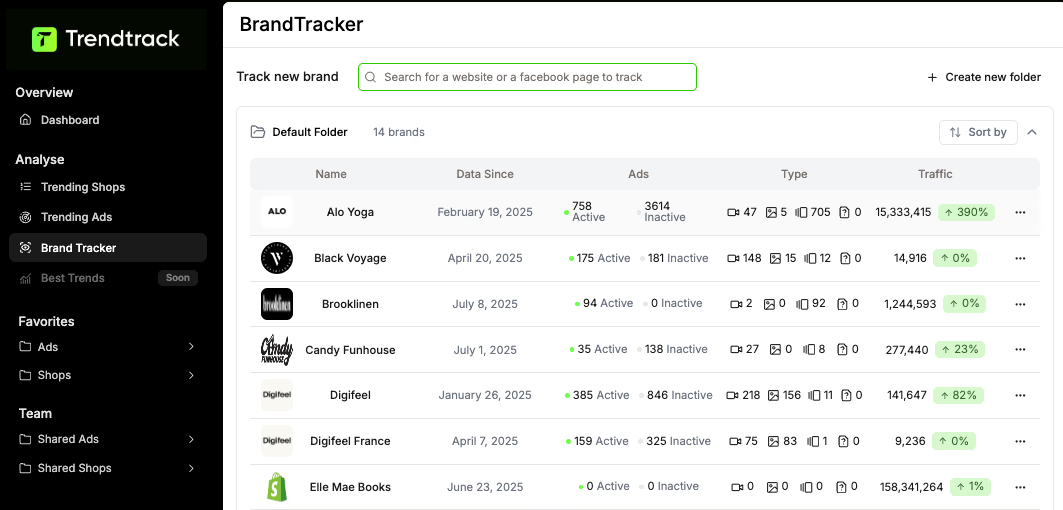
Track a competitor to see their full ad library, active campaigns, and testing patterns. If they suddenly increase ad spend by 300% and try new creative, you know they’ve found something big. Their best ads become your inspiration for what to test next.

You’ll also spot their rhythms. Some brands push hard during certain seasons, others test year-round. Knowing this helps you time your launches and avoid head-to-head battles during their peak periods.
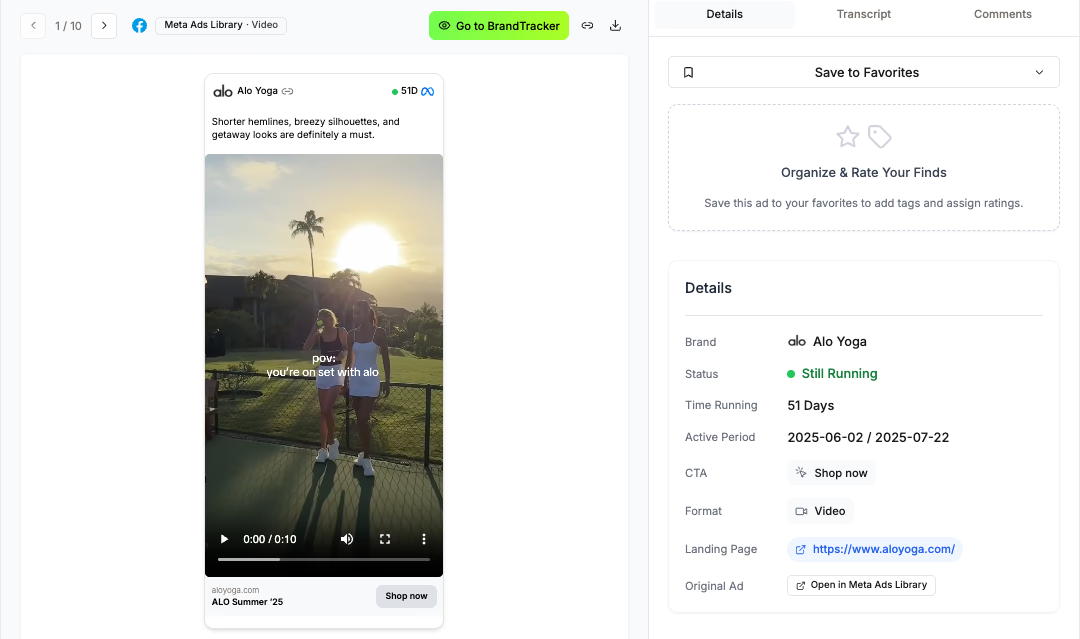
With Trendtrack’s integrated data, you don’t just see what competitors do—you see the results. Traffic spikes, revenue estimates, and engagement metrics give you the full picture.
For example, a competitor’s revenue might kump from $100,000 to $400,000 while testing a new product. You watch a winning move unfold in real time.
Want to take your competitor research beyond basic observation? Discover how the best adspy tools can give you deeper insights into winning campaigns and help you identify profitable opportunities before your competitors do.
The Future of DTC Success Lies in Data-Driven Trend Intelligence
The DTC eCommerce trends reshaping 2025 demand more than passive observation. They require active intelligence gathering and rapid execution.
You can be sure brands that combine zero-party data collection with AI-powered personalization will capture market share before competitors even recognize the shift.
The winners won't just follow trends. They'll anticipate them with precision timing and bulletproof validation.




Are you ready to get the insights?
From viral trends to million-dollar stores — unlock the insights behind what sells, scales, and converts. All in one place.




.avif)

